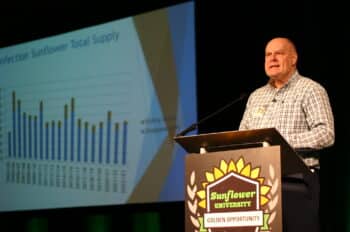Shedding light on why 2023 was a record year for North Dakota growers, and also what to look out for in 2024.
The recent Nuseed Sunflower University event in Bismarck, ND, helped shed light on what new genetics can do for growers regarding boosting yields and weathering both biotic and abiotic stresses.

John Sandbakken | National Sunflower Association Executive Director
2023 stood out for record high sunflower yields in North Dakota. According to John Sandbakken, executive director of the National Sunflower Association, good growing conditions played a pivotal role in augmenting the oil content within crops.
Optimal environmental factors, including sunlight, temperature, and soil quality, collectively contribute to the favorable conditions conducive to bolstering oil yields.
North Dakota hit record sunflower yield last year of 1,970 lbs/ac. The national average came in at its second highest ever — 1,747 lbs/ac.
In 2023, the United States experienced a significant milestone in yields, particularly for confections, marking a brand new high. Over the past two years, confection yields in the U.S. have consistently broken records, with the 2023 crop yielding nearly 2,100 lbs/ac.
“Witnessing this remarkable increase from 1,200 pounds just a few years prior is truly astounding. It underscores the impact of breeding advancements and the dedicated work in developing hybrid varieties with exceptional growth potential,” Sandbakken said.
When it comes to oil acres, the U.S. market tends to fluctuate, influenced by global production and demand dynamics, he noted.
“While we’ve observed shifts in acreage over the years, our focus remains primarily on domestic production rather than exports. Despite a decrease in acres in 2023 following a substantial increase in 2022, the overall trend in the oil market has been positive. We’ve seen notable improvements in yields, with three of the last four years setting record highs or near highs.”
The market for bird food remains stable, albeit not experiencing significant growth. Shifting focus to domestic oil usage, there’s been a notable shift in consumption patterns over the years.
“Twenty years ago, a significant portion of U.S.-produced oil was exported. However, in recent years, the domestic market has become the primary focus, with an impressive 67% increase in sunflower oil consumption over the last five years alone. This growth trend underscores the importance of catering to domestic demand, especially considering the challenges posed by inflation affecting consumer choices,” Sandbakken said.
Regarding exports, while there was a spike in 2021-2022 due to geopolitical events disrupting global supply chains, the main export markets for American sunflower oil remain Canada and Mexico. Despite fluctuations in export volumes, the focus remains on meeting domestic demand, which is expected to continue in the coming years.
“The evolution of the sunflower oil industry in the U.S. is evident in the shift towards high oleic varieties. This transition was accelerated by factors such as patent issues and the challenges of competing in international markets,” Sandbakken added.
“With high oleic varieties becoming increasingly dominant, breeding programs have adjusted their focus accordingly. Highlighting the growing preference for high oleic oil, this trend is expected to continue, shaping the future of the sunflower oil market.”
A pivotal aspect to consider is the goal of seed companies to elevate the oil content in sunflower. Higher oil content renders the crop more valuable. Seed companies invest substantial resources into research and development endeavors aimed at enhancing the genetic makeup of these crops to maximize oil production potential.
“Crucially, the genetic makeup of the crops is a cornerstone in the quest for heightened oil content. The selection and cultivation of specific genetic traits play an important role in enabling the crops to respond effectively to stress-induced stimuli, resulting in an increase in oil production,” Sandbakken added.
Through meticulous breeding programs and genetic engineering advancements, researchers continue to unlock the full potential of these crops, ushering in an era of unprecedented productivity.
Eye on Nutrients
Precision agriculture techniques are increasingly indispensable in the quest for optimal sunflower yields and quality. Central to this is nitrogen and phosphorus application, two elemental components crucial for sunflower growth and development. That was the message from Kyle Okke of Agile Agronomy, who spoke on the topic of fertility.

Kyle Okke | Agile Agronomy
While traditional wisdom often prioritizes phosphate fertility in crop management strategies, emerging research challenges this conventional notion within the context of sunflower cultivation. Okke redirects focus on alternative quality and yield factors, hinting at a paradigm shift in fertility management approaches.
He shed light on the interplay between soil characteristics, previous cropping history, and optimal nitrogen application practices.
“A nuanced understanding of these variables is important in crafting tailored fertilization regimes conducive to maximizing sunflower productivity while mitigating adverse environmental impacts,” he said.
Nitrogen fertilizer application in sunflower farming is another area he places a lot of importance on. Echoing findings from empirical studies, he underscores a notable inverse relationship between nitrogen use and sunflower yield and oil content.
Okke’s insights offered crucial guidance to sunflower growers, particularly those in western North Dakota. Emphasizing the pivotal role of precision agriculture methodologies, Okke advocates for an approach that acknowledges field-level variability and the need for tailored nitrogen recommendations.
“When assessing yields, it’s unrealistic to expect uniformity across the entire field. Instead, we observe areas with varying levels of productivity. In some parts, yields may be as low as 50 to 100 pounds per acre, while in the best-performing areas, yields can soar to over 3,000 pounds per acre. This variability underscores the importance of adopting a zone-based approach to fertility management,” he says.
“We need to tailor our nitrogen application strategies to suit the specific needs of each zone within the field. Often, we find ourselves overapplying nitrogen in poorer areas, where yields are naturally limited. In the most productive zones, we may be underapplying nitrogen. To address this imbalance, I advocate for implementing checks and balances, such as adjusting nitrogen application rates based on zone-specific requirements.”
In addition to nitrogen, potassium emerges as a critical nutrient deserving of attention, particularly in regions like North Dakota, where potassium deficiencies are prevalent in certain zones. Addressing these deficiencies is paramount, as potassium plays a crucial role in water regulation within plants, impacting overall crop health and resilience.
The Importance of pH Levels
While nutrient levels are paramount, pH levels are as well when it comes to influencing the efficacy and stability of herbicides, a point brought forward by Ryan Hunt, technical services manager for FMC Corporation. He underscored how variations in pH levels can exert profound impacts on the solubility and activity of herbicides within aqueous solutions, thereby significantly influencing their performance in weed control.

Ryan Hunt | FMC Corporation Technical Service Manager
“From acidic to alkaline conditions, each pH range exerts distinct effects on herbicide stability, necessitating tailored approaches to water management and herbicide application,” he says.
According to Hunt, water quality issues underscore the imperative of adopting proactive measures to optimize herbicide efficacy while minimizing adverse environmental impacts. By monitoring pH levels and employing appropriate buffering agents where necessary, farmers can mitigate the risk of herbicide degradation and ensure consistent weed control outcomes throughout the growing season.
“By fostering a deeper understanding of the intricate interactions between herbicides and water quality parameters, growers can make informed decisions that balance the imperatives of weed management with ecological resilience and water conservation,” he says.
Watch for Weevils
Patrick Beauzay, entomology research specialist at North Dakota State University, discussed the management of red sunflower seed weevil infestations in South Dakota, highlighting limited insecticide options and exploring unregistered chemistries as alternatives. Beauzay shared information on pest management, including early planting dates and smaller hybrids.

Patrick Beauzay | North Dakota State University Entomology Research Specialist
Another issue that has cropped up is pest resistance to insecticides, specifically resistance of pests to Asana, Warrior, Delta Gold, and chlorpyrifos, the latter of which is currently undergoing scrutiny by the EPA.
His research program is continuing to test additional insecticide products for red sunflower seed weevil control, including chlorantraniliprole and lambda-cyhalothrin. He also encouraged the crowd to consider earlier planting dates and early maturing hybrids to avoid red sunflower seed weevil damage, although he acknowledged this method of control needs more study.
Rust Control
Dr. Sam Markell, professor at North Dakota State University, discussed the importance of early disease management and effective tools, including genetic resistance and fungicides, to control sunflower rust disease in North Dakota.

Dr. Sam Markell | North Dakota State University Professor
“Rust can be very explosive, so scouting for the disease is key to managing it efficiently. At the end of the day, what I hope you’ll remember is this: keep a vigilant eye out for rust, especially this year. We have excellent fungicide options and good genetic resistance,” he said.
Unlike other rusts, sunflower rust overwinters in regions like Manitoba and the Dakotas. It’s highly unpredictable and can spread rapidly under favorable conditions. Rust thrives in humid conditions, so heavy dews of fog can increase the disease quickly.
Markell is particularly concerned about rust in 2024 because the disease was common last fall, and our mild winter may ensure the pathogen survives. Identifying rust early, before a serious epidemic occurs, is crucial for management.
“Firstly, consider eliminating volunteers in your fields to help reduce the early spread. While there’s good resistance out there, the pathogen is unpredictable, so relying solely on genetic resistance may not suffice. Fungicides are excellent tools, and scouting for rust right before bloom will help growers decide if they need an application to protect yield. If an epidemic begins, we can prevent significant yield loss with a single fungicide application at the right timing,” Markell said.
